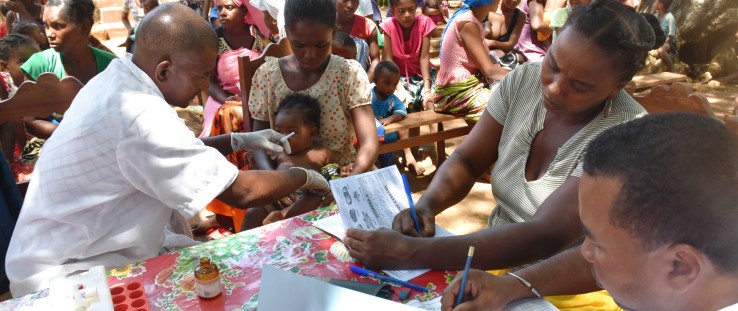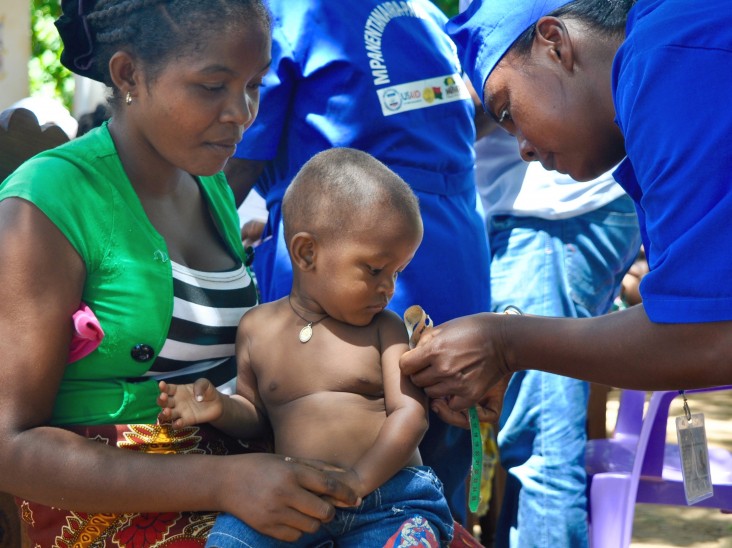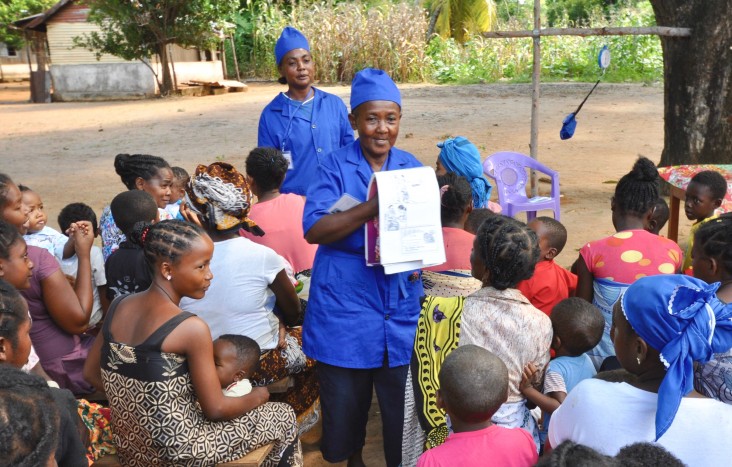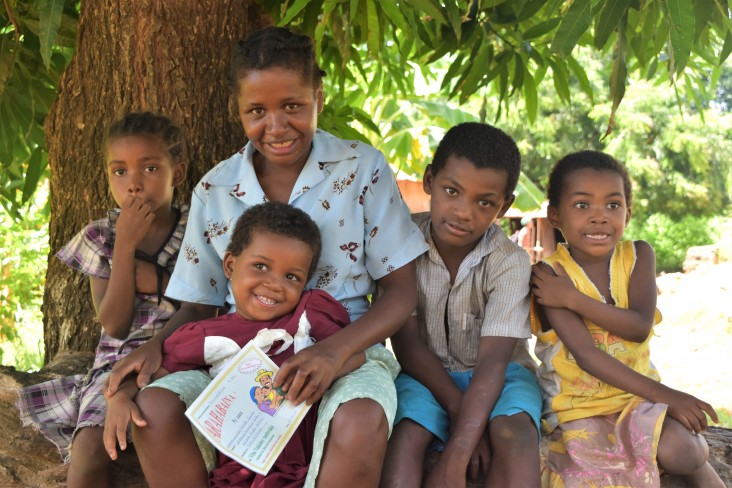 Left to right: district immunization coordinator Gina Biteny, community health volunteer Jeno, and Dr. Jimi Rakotoarimanana provide immunizations in the Analalava district of Madagascar.
JSI
Left to right: district immunization coordinator Gina Biteny, community health volunteer Jeno, and Dr. Jimi Rakotoarimanana provide immunizations in the Analalava district of Madagascar.
JSI
 Left to right: district immunization coordinator Gina Biteny, community health volunteer Jeno, and Dr. Jimi Rakotoarimanana provide immunizations in the Analalava district of Madagascar.
JSI
Left to right: district immunization coordinator Gina Biteny, community health volunteer Jeno, and Dr. Jimi Rakotoarimanana provide immunizations in the Analalava district of Madagascar.
JSI
Speeches Shim
Analalava is a long way from anywhere else. This remote district of rice paddies and vanilla plantations in northwestern Madagascar is very difficult to access by land, especially during the rainy season.
Scattered among these rainforest-covered hills are over 165,000 people, including a number of women of childbearing age and young children.
USAID has been active here since 2013, partnering with the Madagascar Ministry of Public Health and running a community-based health project known locally as MAHEFA (MA-lagasy HE-althy FA-milies). Mahefa means “able” in the Malagasy language.
At the time, Analalava wallowed near the bottom of the list in critical health areas. This included a childhood immunization rate that was below 70 percent and a high rate of newborn deaths.
MAHEFA worked closely with the ministry to help turn things around by addressing the problems presented by isolation, poor roads and hard-to-reach health centers. The program trained thousands of community health volunteers; people chosen by their communities to provide basic health care services and to spot serious cases and get them to medical centers.
Today, vaccination rates hover around 90 percent, and the health of newborns continues to improve.
The Turnaround
The keys to success included a small army of passionate health volunteers as well as leadership from the district’s health leaders.
One of those leaders is Dr. Jimi Rakotoarimanana, a dedicated health care professional who moved to Analalava seven years ago to lead its district hospital. Three years later, he became the district’s medical inspector, tasked with preserving and improving the health of citizens across the district and protecting the population from major health threats.
Soon after he started the job, Rakotoarimanana identified a number of critical problems, including a lack of basic supplies at primary health centers and unreliable operating hours, making it hard for people to know when they could see a doctor. But the main problem he saw was that district health workers had a hard time reaching people in some of the more remote villages.
Working with MAHEFA, Rakotoarimanana helped the district health team train, equip and supervise 360 health volunteers.
“I saw that these volunteers could act as extensions of the government-run health facilities and provide basic services in their communities,” he says. “In remote areas such as Analalava, community health volunteers now play a key role in reducing the maternal and child mortality rate through their services.”
Community health volunteers in Analalava were tasked with a wide array of services that had previously been lacking: promoting good health practices and hygiene, providing family planning services, and diagnosing and treating simple cases of malaria, diarrhea and pneumonia for children under age 5.
They were also trained to monitor newborns, promote proper nutrition, and refer women and children to primary health centers for prenatal care, delivery, vaccinations and emergency treatment.
Since she became a community health volunteer in 2011, Marie Jeanne Mbiavy has been an essential part of providing for her community’s health needs. She was driven to become a health volunteer by the opportunity to learn new skills and help her family and neighbors.
In March 2016, she put her new skills to vital use when a concerned mother brought her 2-year-old daughter to Mbiavy. Because the child had a fever, Mbiavy did a rapid diagnostic test. The result was positive for malaria. Mbiavy could see the young girl was showing warning signs of severe malaria that she’d been trained to spot, so she immediately took the child and the mother to the nearest primary care center. The supervisor there told Mbiavy that she had acted just in time and they were able to successfully treat the girl. Mbiavy calls it her proudest moment.
One of the main goals Rakotoarimanana set was to improve the low rate of childhood immunizations. He formed a team composed of district staff and community health volunteers.
Among those who benefited were 31-year-old Soatiana Marie Ortense and her five children. All of Ortense’s children have now completed the full vaccination series, which gives her comfort.
“I am more optimistic now that my little Fabiolette has (received her vaccinations) because she will have a better future,” she says, resting beneath a tree in her village and holding the little girl on her lap under the dappled shade. “My dream is that she will one day become a doctor, to take care of us all later.”
Ortense has since become an advocate for immunizations, encouraging her sister-in-law to have her first child vaccinated.
Rakotoarimanana attributes the progress in his district to the region’s partnership with MAHEFA and its follow-on project, Mahefa Miaraka, as well as the hundreds of community health volunteers who have stepped up to take care of their own. “We would never have achieved such health results without their involvement. It has been possible thanks to them and the MAHEFA and Mahefa Miaraka programs and their support.”






Comment
Make a general inquiry or suggest an improvement.